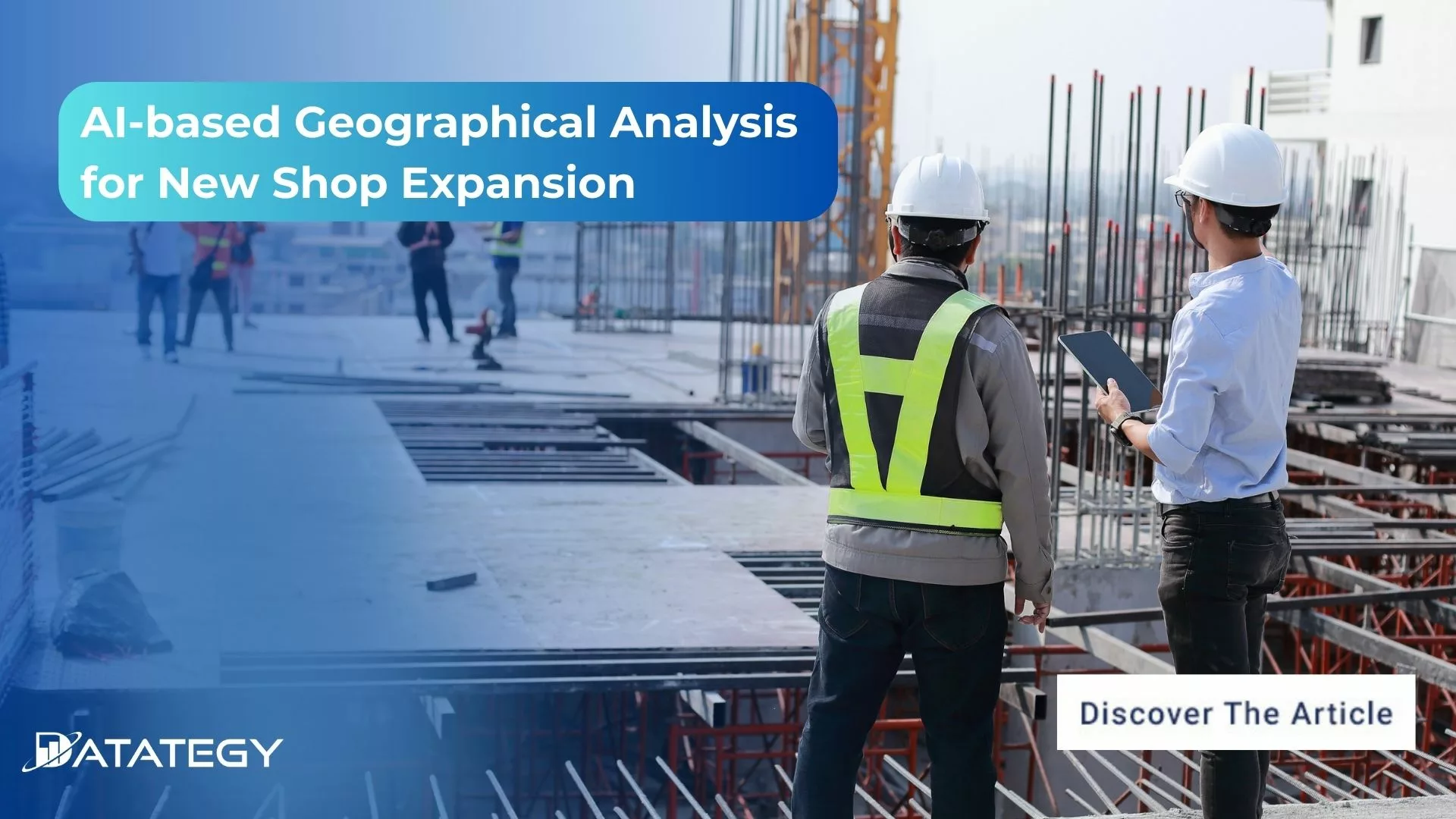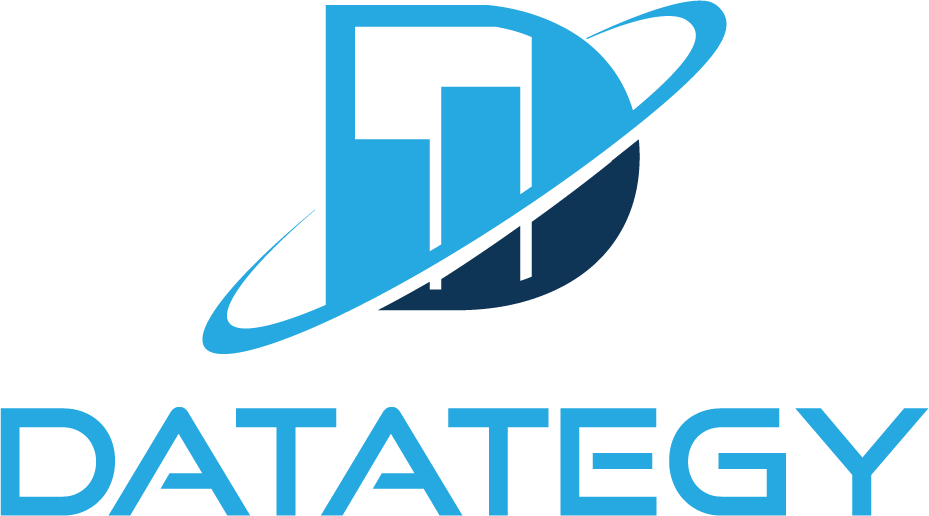Transform Defense Logs & Rapport into Situational Awareness with AI...
Read MoreAI-based Geographical Analysis for New Shop Expansion
Table of Contents
ToggleIn a world where e-commerce has won over many new consumers, traditional shops are in constant competition. nevertheless, they remain an important place for promoting products, providing after-sales service and attracting specific customers.
Selecting a new location for a shop or mall can have a big impact on how well it does financially. Artificial intelligence can assist with this decision-making process.
AI algorithms can analyze demographics, foot traffic patterns, and competitor proximity to suggest optimal locations for your new shop, leading to higher foot traffic and sales. A study by MIT found that retailers who used AI for location selection saw a 10% increase in sales.
Find out how papAI can improve the deployment of AI projects in Sales Teams.
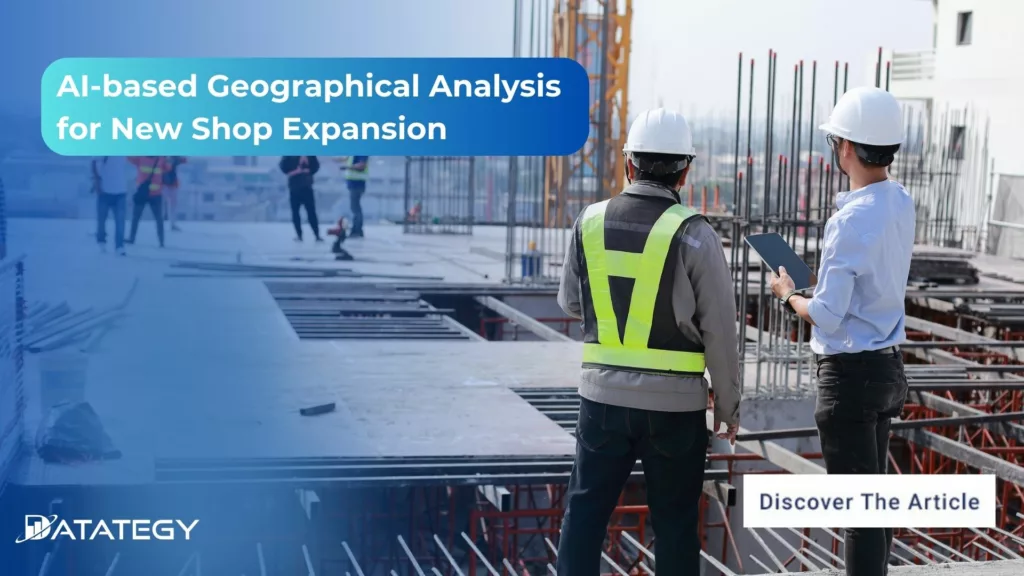
In this article, we’ll look at how AI can be used to address this use case, and what its benefits are for improving profits and productivity.
Former Store Expansion Strategies
The majority of expanding shop strategies used to entail sticking with time-tested, conventional techniques. To identify possible store locations, one popular strategy was to thoroughly examine market research reports and demographic data. This required investigating specifics such as population density, income distribution, and purchasing patterns in various locales. Although it gave a basic understanding, it was laborious and occasionally failed to fully depict the preferences of the target audience.
An additional older technique was the traditional site visit. Retailers would drive around to various locations to measure foot traffic, observe rivals, and evaluate market potential. While it provided real-time insights and was a hands-on approach, it was also labor-intensive and frequently depended heavily on subjective observations and gut instincts.
Introduction to AI-based Geographical Analysis
The importance of strategic location selection in the context of business expansion cannot be emphasized. In this quest, geographic analysis powered by AI proves to be a highly effective instrument. Fundamentally, artificial intelligence (AI) endows machines with the capacity to process and comprehend data in a manner similar to that of human cognition.
In contrast, geographic analysis explores spatial data in order to identify patterns and relationships relevant to specific geographic locations. The combination of these fields creates the foundation for Geographical Analysis powered by AI, providing companies with an advanced way to handle the challenges involved in choosing a location.
Geographical analysis powered by AI goes beyond just pinpointing potential sites for businesses. It encompasses economic dynamics, transportation infrastructures, and environmental considerations in a comprehensive understanding of the geographic landscape. These thorough insights enable companies to make wise decisions and match expansion plans with complex local environments.
Adoption of AI-based Geographical Analysis promises to revolutionize expansion endeavors, providing a strategic compass in navigating the complexities of geographical markets, regardless of the size of the enterprise—a burgeoning startup or an established conglomerate.
Which are the Fundamental Technologies Behind Geographical Analysis with AI?
Machine learning:
The foundation of artificial intelligence (AI)-based geographic analysis is machine learning algorithms, which allow computers to learn from data and make predictions or decisions without explicit programming.
These algorithms are trained on spatial datasets that contain data such as geographic coordinates, land use patterns, population demographics, and more when used in geographical analysis. Machine learning algorithms can find intricate patterns and relationships in these datasets through iterative training and optimization processes, which enables the creation of predictive models and decision-making tools.
Systems of Geographic Information (GIS):
GIS systems are an effective means of gathering, storing, processing, and displaying spatial data. GIS technology offers a framework for combining various geographic data sources, including maps, satellite images, aerial photos, and demographic information, into a cohesive system when used in geographical analysis.
This gives users the ability to compare and overlay various spatial information layers to understand spatial patterns and relationships.
Remote Sensing:
AI-based geographical analysis relies heavily on remote sensing technologies to provide useful spatial data about Earth’s surface and atmosphere. These technologies gather detailed data about the Earth’s surface, including vegetation, terrain, land cover, and more, using sensors installed on satellites, airplanes, drones, and other platforms.
Applications for this spatial data are numerous and include natural resource management, urban planning, disaster response, and environmental monitoring.
What are the Benefits of Using AI in Sales Expansion?
Reduce costs and gain efficiency: Streamlining the expansion process and saving time and money are two major benefits of AI-based geographical analysis. Businesses may speed up their expansion process and cut costs associated with manual labor and trial-and-error methods by automating data collection, analysis, and decision-making.
This effectiveness maximizes an organization’s return on investment in new store locations by enabling resource allocation more skillfully.
Reducing risk: By offering thorough insights into potential obstacles and opportunities, AI-based geographical analysis helps reduce the risks associated with opening new stores.
Businesses can recognize and manage possible risks before they worsen by examining variables like regional laws, environmental concerns, and economic trends. This proactive strategy makes sure that expansion efforts go smoothly and reduces the possibility of expensive setbacks.
Accuracy in Site Selection: When it comes to location selection, AI-based geographical analysis provides a level of accuracy that is difficult for traditional methods to match.
Businesses can pinpoint the most promising locations with extreme precision by utilising sophisticated algorithms and large datasets. By minimising the possibility of choosing less-than-ideal locations, this accuracy guarantees that new stores are positioned to optimize foot traffic and revenue potential.
Optimization of Resource Allocation: For a shop to expand efficiently, resource allocation must be optimized. Businesses may more efficiently manage staffing, inventory, and marketing budgets by utilising AI-based geographic analysis.
Organizations can strategically allocate resources to maximize return on investment and minimize waste by identifying areas with high demand and growth potential. This guarantees that resources are allocated to the most productive areas, increasing operational effectiveness and financial gain.
Which Type of Company can Leverage AI for Shop Expansion?
Franchise Businesses: Artificial intelligence (AI) can be used to speed up the process of choosing franchise locations for businesses like fast-food chains, coffee shops, and convenience stores. In order to identify underserved markets and high-demand areas where new franchise locations are likely to succeed, artificial intelligence (AI) algorithms can analyze market data and customer demographics.
Retail Chains: AI can be used by retail chains, such as grocery stores, electronics stores, and clothes stores, to determine the best places to open new locations. Retail chains can identify high-traffic areas with the greatest potential for sales growth by analyzing demographic data, consumer behavior patterns, and competitor locations.
Tourism and hospitality Chains: AI can be used by hospitality chains, including hotels, resorts, and restaurants, to grow their retail businesses and diversify their sources of income. In order to find opportunities for retail expansion within hospitality properties, such as gift shops, boutiques, and specialty stores, AI algorithms can analyze guest data, visitor demographics, and tourism trends.
AI and Machine Learning for Sales:
The Key to Unlocking Growth Potential
The development of artificial intelligence (AI) has significantly changed the sales industry, which has witnessed a remarkable evolution throughout time. The way companies approach sales processes and strategies has been completely transformed by AI. In this white paper, we will examine the concept of AI in sales, its historical evolution, and the advantages it provides for companies.

How you can Implement AI in your Sales Teams?
1- Evaluation of Needs: Before integrating AI into your sales teams, it’s critical to conduct a comprehensive evaluation of the requirements and problems facing your company. Determine which particular domains, like lead generation, customer segmentation, or sales forecasting processes, AI can have a big impact on.
Gain a better understanding of the challenges and goals of your sales team so that you can customize AI solutions to meet their specific needs and optimize implementation benefits.
2- Examine AI Solutions: Look into the different AI options on the market that fit your goals and needs. Seek out systems or resources that provide functions like natural language processing, sales automation, or predictive analytics. Consider features, scalability, and ease of integration with your current systems when weighing your options.
3- Pilot Testing Phase: To determine whether implementing AI in the real world is effective, begin with a phase of pilot testing. To test the AI solution and get user feedback on its usability, functionality, and impact on workflows, choose a small team or a particular use case. Use the knowledge gathered from the pilot test to improve the implementation strategy and deal with any problems or obstacles that crop up.
4- Measurement and Analysis: To determine how implementing AI will affect sales performance, set up specific KPIs. To evaluate the success of AI-driven initiatives, monitor metrics like lead conversion rates, customer acquisition costs, and sales pipeline velocity.
To assess performance trends, pinpoint areas for success, and identify areas for improvement, use data analytics and reporting tools. Review and assess performance metrics on a regular basis to make sure AI implementation is producing the desired effects and producing observable business outcomes.
5- Expanding Up: Extend the use of AI in your sales teams after you’ve conducted pilot testing to confirm its efficacy in your processes. Provide resources and assistance to ensure a smooth expansion process, as well as instruction and direction to ensure new users are successfully onboarded.
Keep an eye on an AI solution’s scalability to make sure it can handle expanding demands and changing business needs. As you grow, keep improving and fine-tuning the AI implementation to guarantee optimal productivity and efficacy throughout your sales team.
Use Case: Using papAI Solution for Flood Risk Prediction in Location Selection
Context
In the pursuit of optimal location selection for supermarkets and warehouses, the assessment of various factors is pivotal, with flood risk emerging as a critical consideration. Floods can have devastating consequences on supply chain operations, causing disruptions, inventory damage, and infrastructure loss. Recognizing the imperative of proactively addressing flood risk.
Using papAI solution, We were able to conduct a comprehensive data analysis aimed at identifying potential flood-prone locations. This dataset contains information on various factors that may influence flood risk.
The dataset includes several features representing environmental, social, infrastructure, and governance-related factors that could impact the likelihood and severity of flooding events. Additionally, it includes a target variable, “FloodProbability,” which may indicate the likelihood of flooding occurring in different potential locations
1- Data Importation
With papAI interface, importing data into the platform becomes effortless. The dataset had been pre-divided into two sets for distinct purposes, the first set, comprising 950263 rows, was designated for training, while the second set, with 81962 rows, was allocated for testing.
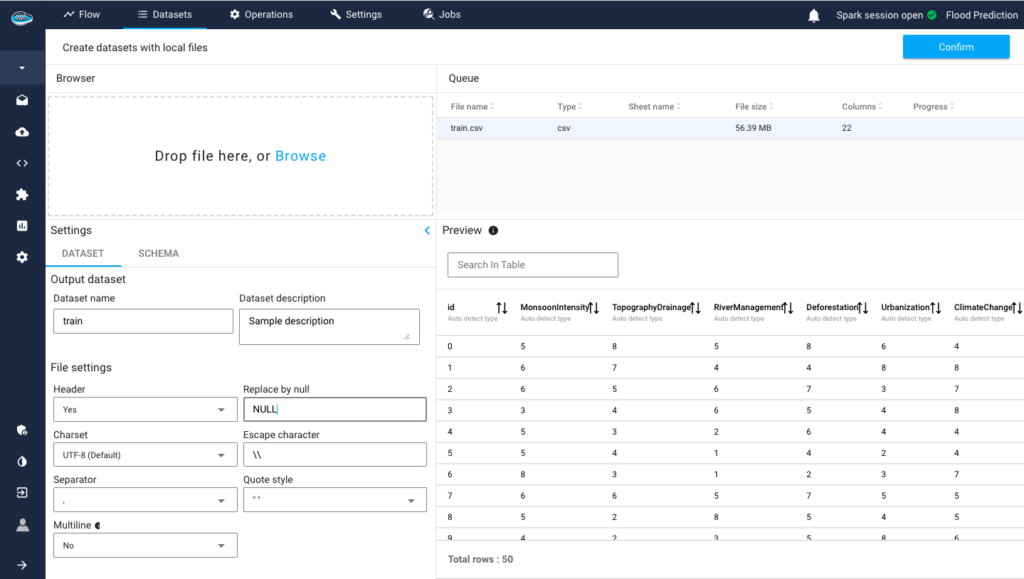
2- Data Exploration
Thanks to papAI’s data visualization module, users can explore a variety of graphical representations, including 2D, 3D, and cartographic visuals, enabling in-depth analysis and assessments of datasets. In this case, we depicted a histogram distribution of the flood dataset, providing a visual representation of the distribution pattern.
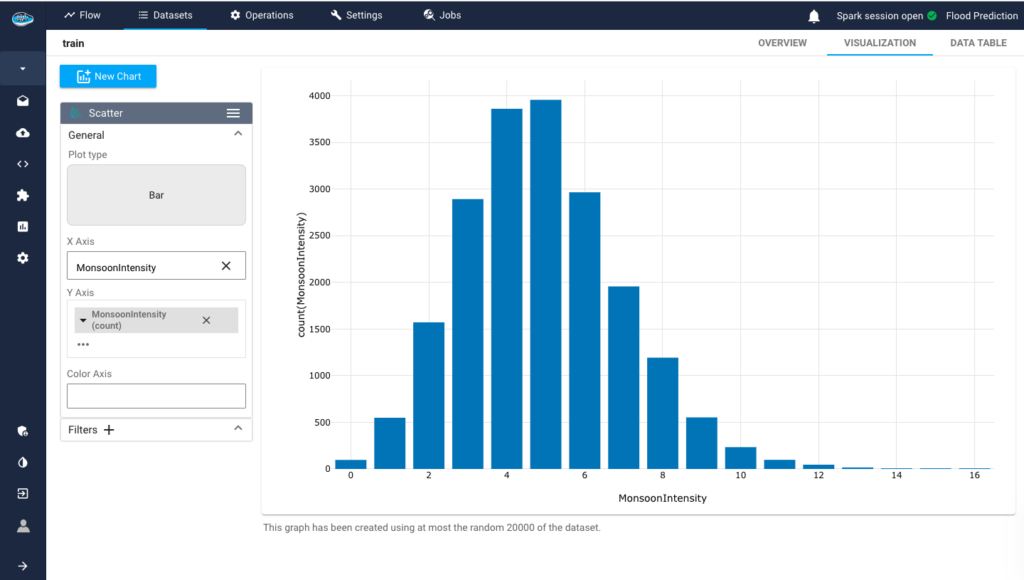
The dataset consists of 21 columns, each representing a different factor related to flood probability or vulnerability. For most features, the distribution seems to be centered around the mean, with some variability and possible outliers towards the tails of the distribution.
papAI further enhances its functionality with an automated statistics calculation feature, providing users with a comprehensive understanding of the Dataset features through detailed statistical analysis.
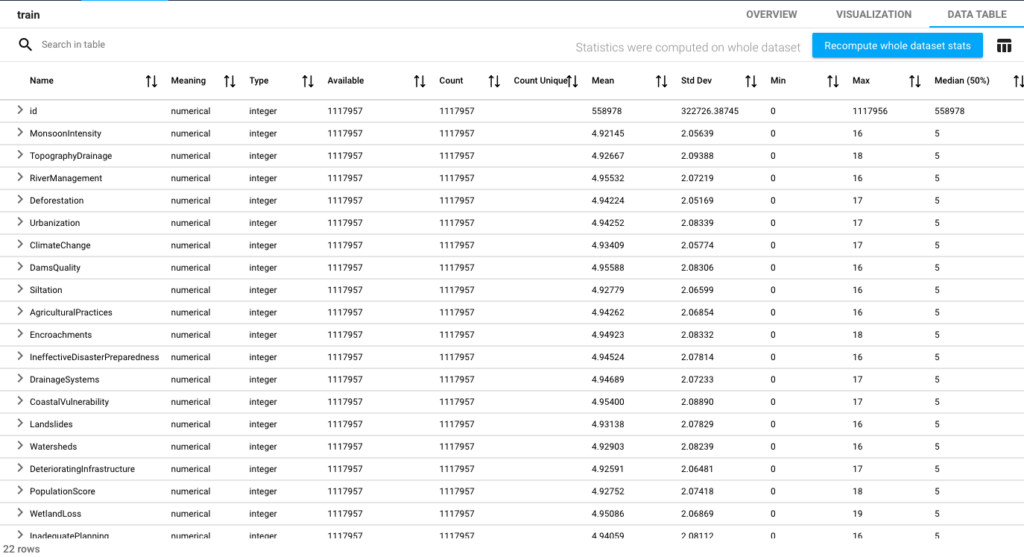
The features appear to be scored or rated on a scale, as indicated by the mean values ranging around 4-5 with a standard deviation of around 2.
We also conducted a correlation heatmap analysis to identify features strongly correlated with flood probability. Clear patterns or strong correlations with ‘FloodProbability’ may serve as crucial predictors of flood risk
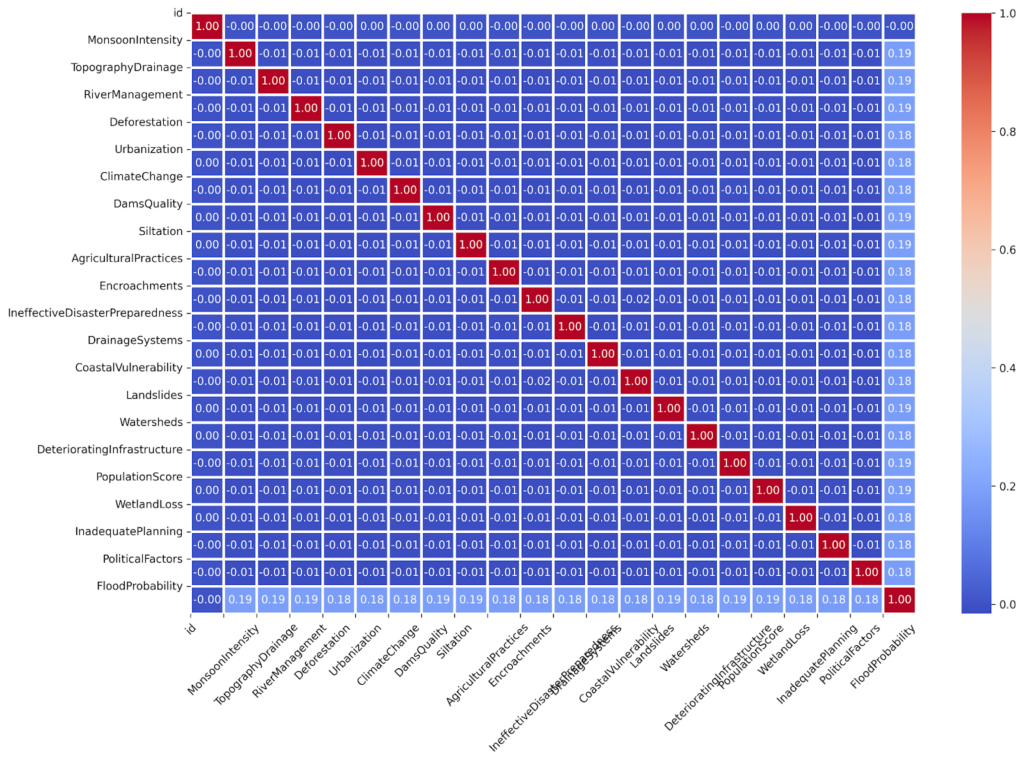
Some features have relatively higher absolute correlation coefficients with ‘FloodProbability‘ than others.
Certain features exhibit higher inter-feature correlations, suggesting potential multicollinearity issues. For instance, ‘Urbanization’ and ‘CoastalVulnerability’ have a coefficient of 0.180861, indicating a moderate positive correlation between these two features.
3- Machine Learning
Data Training
papAI’s Machine Learning Lab provides an extensive array of pre-built machine learning algorithms and model selection tools. Selecting the appropriate algorithm is pivotal for precise flood predictions. Users can explore different algorithms, including Logistic Regression, Random Forest, Gradient Boosting, and Neural Networks, empowering them to fine-tune their models for optimal performance and accuracy in flood prediction tasks
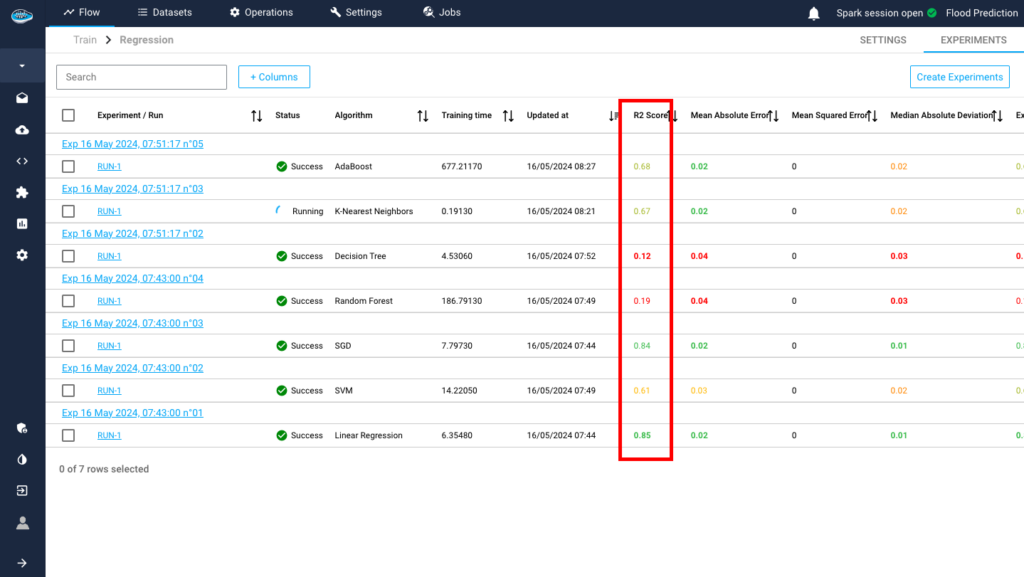
Model Evaluation
After concluding the training of your model, conducting a rigorous evaluation of its performance is essential. In papAI’s Machine Learning Lab, users can see detailed reports on how well models perform.
These reports show predicted values compared to actual values, the spread of errors, and any biases in the errors. This helps users understand the average or most frequent values in each group. These detailed reports enable thorough examination and validation of model efficacy, ensuring robust performance assessment.
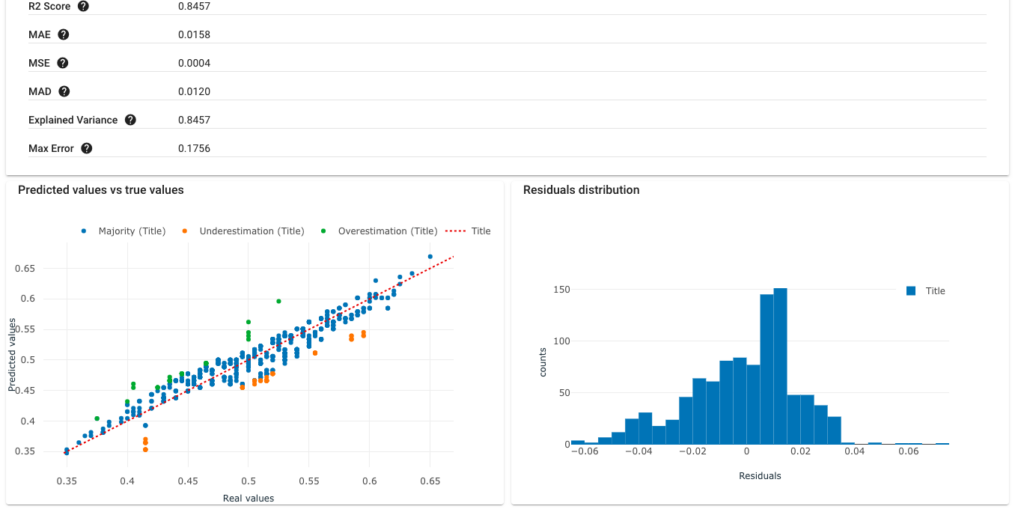
4- Interpretability & Explainability (XAI)
By leveraging papAI’s Interpretation feature, businesses in the supermarket and supply chain industry can discern the key factors influencing flooding in potential locations.
This insight holds significant importance as it allows businesses to mitigate risks and optimize their site selection strategies. Identifying areas prone to flooding enables proactive engagement with local authorities to implement preventative measures, safeguarding supply chains and ensuring uninterrupted operations.
This proactive approach not only enhances operational resilience but also contributes to cost savings and strengthens the business’s competitive edge in the market.
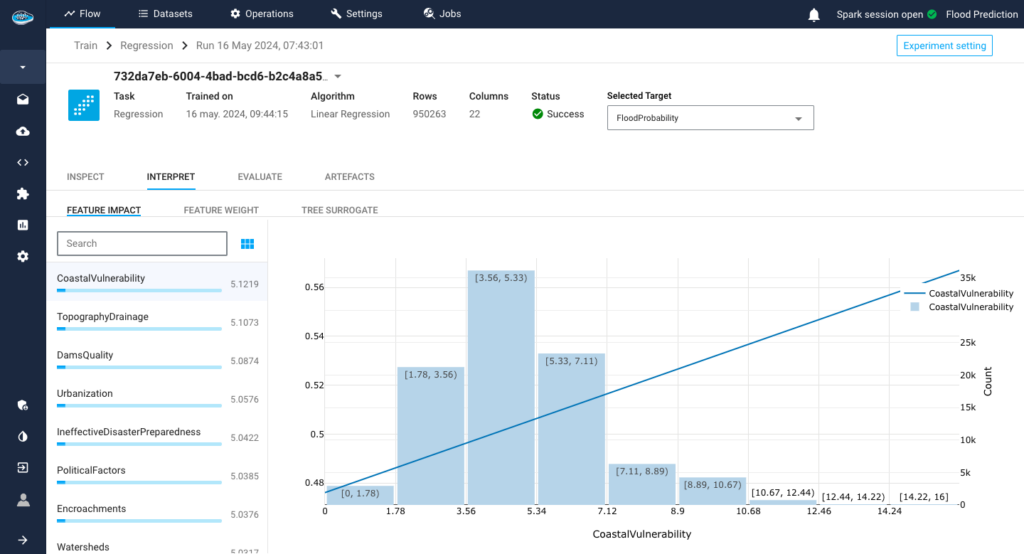
Using a filter operation integrated into the platform, we could obtain only the locations with a lower ‘FloodProbability’.

Upon completion, our robust model stands ready for application across additional locations, offering insights into the optimal choices for site selection. For example, leveraging our dataset, we identified 200 locations characterized by a low probability of flooding.
This capability empowers businesses in the supermarket and supply chain industry to make informed decisions regarding expansion or establishment of new outlets, ensuring resilience against potential disruptions and maximizing operational efficiency.
Create your AI-based Tool to Enhance Your Shop Expansion Strategies using papAI Solution
Are you ready to revolutionize your shop expansion strategy with advanced geographical analysis? Discover how you can harness the power of AI with papAI to pinpoint the best locations for your new shops, analyze market trends, and optimize your expansion efforts.
With papAI, you can use advanced tools to decide where to expand. Our platform analyzes data to find ideal locations based on demographics and economics. By studying local demographics, income, and shopping habits, you can choose areas where your stores are likely to succeed.
Schedule your demo today. Our team of AI specialists is poised to assist you in crafting a bespoke AI-based solution perfectly tailored to your organization’s unique needs.
Interested in discovering papAI?
Our AI expert team is at your disposal for any questions
Why AIOps Is Key to Cyber Threat Detection in Defense?
Why AIOps Is Key to Cyber Threat Detection in Defense?...
Read MoreHow AI Transforms Predictive Maintenance in Defense Equipment
How AI Transforms Predictive Maintenance in Defense Equipment In a...
Read MoreHow to Scale AI Without Breaking Your Infrastructure in 2025
How to Scale AI Without Breaking Your Infrastructure in 2025...
Read More